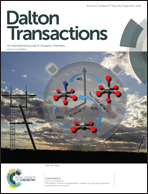Nickel L-edge and K-edge X-ray absorption spectroscopy of non-innocent Ni[S2C2(CF3)2]2n series (n = −2, −1, 0): direct probe of nickel fractional oxidation state changes
Abstract
A series of nickel dithiolene complexes Ni[S2C2(CF3)2]2n (n = −2, −1, 0) has been investigated using Ni L- and K-edge X-ray absorption spectroscopy (XAS). The L3 centroid shifts about 0.3 eV for a change of one unit in the formal oxidation state (or 0.3 eV per oxi), corresponding to ∼33% of the shift for Ni oxides or fluorides (about 0.9 eV per oxi). The K-edge XAS edge position shifts about 0.7 eV per oxi, corresponding to ∼38% of that for Ni oxides (1.85 eV per oxi). In addition, Ni L sum rule analysis found the Ni(3d) ionicity in the frontier orbitals being 50.5%, 44.0% and 38.5% respectively (for n = −2, −1, 0), in comparison with their formal oxidation states (of Ni(II), Ni(III), and Ni(IV)). For the first time, direct and quantitative measurement of the Ni fractional oxidation state changes becomes possible for Ni dithiolene complexes, illustrating the power of L-edge XAS and L sum rule analysis in such a study. The Ni L-edge and K-edge XAS can be used in a complementary manner to better assess the oxidation states for Ni.
![Graphical abstract: Nickel L-edge and K-edge X-ray absorption spectroscopy of non-innocent Ni[S2C2(CF3)2]2n series (n = −2, −1, 0): direct probe of nickel fractional oxidation state changes](/en/Image/Get?imageInfo.ImageType=GA&imageInfo.ImageIdentifier.ManuscriptID=C4DT00308J&imageInfo.ImageIdentifier.Year=2014)

 Please wait while we load your content...
Please wait while we load your content...